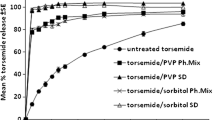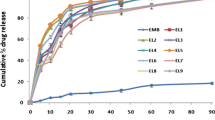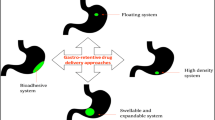Abstract
The present research work was undertaken to optimize and formulate Promethazine Theoclate as a fast dissolving tablet using pore forming technology that disintegrates or dissolves rapidly and offer a suitable approach for the treatment of nausea and vomiting. Fast dissolving tablets of Promethazine Theoclate was prepared by increasing the solubility i.e. using β-cyclodextrin, crospovidone, and menthol. A 33 full factorial design was employed to investigate the combined influence of these three independent variables, i.e., amount of menthol, crospovidone and β-cyclodextrin on disintegration time, percentage friability and percentage drug release after 5 min. In the optimization study, multiple regression analysis has revealed that an optimum amount of menthol, crospovidone and β-cyclodextrin gives a rapidly disintegrating/dissolving tablet. In order to prove the validity of the evolved mathematical model a checkpoint batch was also prepared. Optimized tablets were prepared with an optimum amount of β-cyclodextrin, menthol and crospovidone which disintegrated in the 30 s, having friability 0.599% and released drug 89% after 5 min.
Similar content being viewed by others
References
Bi, Y., Sunada, H., Yonezawa, Y., Dayo, K., Otsuka, A., and Iida, K., Preparation and evaluation of a compressed tablet rapidly disintegrating in oral cavity. Chem. Pharm. Bull., 44, 2121–2127 (1996).
Corveleyn, S. and Remon, J. P., Formulation and production of rapidly disintegrating tablets by lyophilization using hydrochlorthiazide as a model drug. Int. J. Pharm., 152, 215–225 (1997).
Gohel, M. C., Patel, M. M., Amin, A., Agrawal, R., Dave, R., and Bariya, N., Formulation design and optimization of mouth dissolving tablets of nimuslide using vacuum drying technology technique. AAPS PharmSciTech, 5, E36 (2004).
Gregory, R. E. and Ettinger, D. S., 5-HT3 receptor antagonists for the prevention of chemotherapy-induced nausea and vomiting: a comparison of their pharmacology and clinical efficacy. Drugs, 55, 173–189 (1998).
Habib, W., Khankari, R., and Hontz, J., Fast-dissolving drug delivery systems: critical review in therapeutics. Crit. Rev. Ther. Drug Carrier Syst., 17, 61–72 (2000).
Heinemann, H. and Rothe, W., Preparation of porous tablets. U. S. Patent, 3885026, May 20 (1975).
Knistch, A., Hagen, E., and Munz, H. D., Production of porous tablets. U. S. Patent, 4134843, January 16 (1979).
Late, S. G., Yi-Ying, Y., and Banga, A. K., Effect of disintegration promoting agent, lubricants and moisture treatment on optimized fast disintegrating tablets. Int. J. Pharm., 365, 4–11 (2009).
Li, S., Lin, S., Chien, Y. W., Daggy, B. P., and Mirchandani, H. L., Statistical optimization of gastric floating system for oral controlled delivery of calcium. AAPS PharmSciTech, 2, E1 (2001).
Nazzal, S. and Khan, M. A., Response surface methodology for the optimization of ubiquinone self-nanoemulsified drug delivery system. AAPS PharmSciTech, 3, E3 (2002).
Remon, J. P. and Corveleyn, S., Freeze-dried rapidly disintegrating tablets. U. S. Patent, 6010719, January 4 (2000).
Seager, H., Drug delivery products and the zydis fast dissolving dosage forms. J. Pharm. Pharmacol., 50, 375–382 (1998).
Thompson, D. G., Richelson, E., and Malagelada, J. R., Perturbation of gastric emptying and duodenal motility via the central nervous system. Gastroenterology, 83, 1200–1206 (1982).
Ward, A. E., Studies of prochlorperazine as a buccal tablet and a oral tablet for the treatment of dizziness, nausea and vomiting in a general practice setting. Br. J. Clin. Pract., 42, 228–232 (1988).
Author information
Authors and Affiliations
Corresponding author
Rights and permissions
About this article
Cite this article
Sharma, S., Sharma, N. & Das Gupta, G. Optimization of promethazine theoclate fast dissolving tablet using pore forming technology by 3-factor, 3-level response surface-full factorial design. Arch. Pharm. Res. 33, 1199–1207 (2010). https://doi.org/10.1007/s12272-010-0810-4
Received:
Revised:
Accepted:
Published:
Issue Date:
DOI: https://doi.org/10.1007/s12272-010-0810-4




